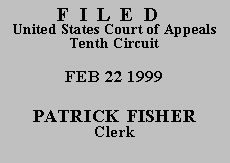

| HERMAN VILLANUEVA,
v.
JOE WILLIAMS, Warden, Central
New Mexico Correctional Facility;
|
No. 98-2196
(D.C. No. CIV-97-1442-BB) |
Herman Villanueva, a pro se state prisoner, filed this petition for federal habeas corpus relief pursuant to 28 U.S.C. § 2254. The district court adopted the recommendation of the magistrate judge that the action be dismissed as time-barred and denied Mr. Villanueva's request for a certificate of appealability. Mr. Villanueva appeals. We deny his motion for a certificate of appealability and dismiss the appeal.
Mr. Villanueva filed his petition on November 7, 1997, and this proceeding is therefore governed by the provisions of the Antiterrorism and Effective Death Penalty Act of 1996, Pub.L. No. 104-132, 110 Stat. 1214 (Apr. 24, 1996) (AEDPA). That Act establishes a one-year limitation period for filing habeas petitions seeking relief from state court convictions, which begins to run on the date "the judgment became final by the conclusion of direct review or the expiration of the time for seeking such review." 28 U.S.C. § 2244(d)(1)(A). The AEDPA further provides that the limitation period is tolled for the period "during which a properly filed application for State post-conviction or other collateral review with respect to the pertinent judgment or claim is pending." Id. § 2244(d)(2).
Mr. Villanueva challenges a judgment and sentence entered on January 5, 1995, and a parole revocation and commitment order entered on March 20, 1995. His direct appeal of those judgments became final on December 22, 1995, when the state supreme court dismissed his petition for certiorari. Because his convictions became final before the AEDPA's effective date of April 24, 1996, the one-year limitation period began to run on that date. See Hoggro v. Boone, 150 F.3d 1223, 1225 (10th Cir. 1998).
Mr. Villanueva filed his petition for state habeas relief on April 22, 1997. Relief was summarily denied on July 18, 1997, and Mr. Villanueva sought reconsideration of that denial on August 7, 1997, by a motion for reconsideration under the state rules of civil procedure. The state district court did not rule on the request for reconsideration and Mr. Villanueva filed a petition for writ of certiorari with the state supreme court on August 19, 1997. That court issued two orders denying the writ on September 8 and September 19, 1997. Mr. Villanueva filed his petition for federal habeas relief on November 7, 1997.
With this time-table in mind, we must determine whether Mr. Villanueva's federal petition is timely. Mr. Villanueva's state petition was filed on April 22, 1997, within the one-year grace period that had begun to run on April 24, 1996. That period was thus tolled while his state habeas proceedings were pending, leaving him with two days after the completion of those proceedings within which to file his federal habeas petition. Although the state proceedings were completed at the latest on September 19, 1997, Mr. Villanueva did not file his federal petition until November 7, 1997, long after the expiration of the two-day period remaining in his one-year grace period after the tolling had been completed. Accordingly, we agree with the district court that his section 2254 petition was not timely under the AEDPA.
Mr. Villanueva argues that because the state district court never ruled on his motion for reconsideration, his state proceedings are still pending and the limitation period applicable to his federal petition is still tolled. We are not persuaded. Mr. Villanueva moved for reconsideration pursuant to the state rule of civil procedure analogous to Fed. R. Civ. P. 60, which provides for relief from a final judgment for inadvertence and excusable neglect. See N.M. R. Civ. P. 1-060. Although the state district court never ruled on the motion, we disagree that the state proceedings must therefore still be considered pending. The New Mexico Supreme Court has made clear that state post-conviction habeas petitions are not appropriately characterized as civil actions, and that such actions are therefore not controlled by the New Mexico Rules of Civil Procedure. See Caristo v. Sullivan, 818 P.2d 401, 406-07 (N.M. 1991). Mr. Villanueva's motion for reconsideration was thus not "properly filed" within the tolling provision of section 2244(d)(2), and it therefore did not toll the running of the grace period.
Accordingly, Mr. Villanueva's section 2254 petition was not timely.
Because Mr. Villanueva has not "made a substantial showing of the denial of a constitutional right" as required for the issuance of a certificate of appealability, 28 U.S.C. § 2253(c)(2), we DENY his motion for a certificate and DISMISS the appeal.
ENTERED FOR THE COURT
Stephanie K. Seymour
Chief Judge
*.This order and judgment is not binding precedent, except under the doctrines of law of the case, res judicata, or collateral estoppel. The court generally disfavors the citation of orders and judgments; nevertheless, an order and judgment may be cited under the terms and conditions of 10th Cir. R. 36.3.